the history of yeovil's pubs
PUBS HOME PAGE |
PUBS INTRODUCTION |
PUBS BY NAME |
BEERHOUSES |
king's head inn (1)
High Street
Known before the mid-17th century as the Cock in the Hoop, the King’s Head Inn (marked as 'D' on the 1886 map below) was a three storey building with a two-storey bay to the front elevation. It stood on the corner of High Street and George Court, nearly opposite the Mermaid Hotel but slightly down towards the Borough, and was a well-known posting house. Its frontage measured 38 feet (11.6m).
The origin of the name 'Cock in the Hoop' is explained in 'English Inn Signs' by Larwood & Hotton (1951, p303) "Anciently, instead of being a painted board, the object of the sign sometimes was carved and hung within a hoop, hence many of the signs are called the "---- in the Hoop". These Hoops seem to have originated in the highly ornamented bush or crown which latterly was made of hoops and covered with evergreen."
The advertisement of 1823 shown below gives a good description of the inn's facilities "having underground and other cellars, a commodious dining room, a large parlour, and several comfortable bedrooms, together with a large store room, brew house, four good stables, wash house, back kitchen, larder, yard, and other convenient appendages.... and a communication with South Street."
The penultimate landlord, John Melmoth, was born around 1786 in Somerset and appears in the 1841 census as an inn keeper with his wife, Betty, and their three daughters.
The final landlord was Joseph Dean and the Western Gazette noted in 1848 "Joseph Dean (late of the King's Head Inn) informs his friends that, in consequence of the site on which the King's Head premises are situated being required for the new Town Hall and market, he has purchased the stock, &c., of Mr John Thomas of the Castle Inn and will succeed to the business there at Lady-day next."
The Kings Head Inn was bought in 1848 by the Corporation of Yeovil and demolished the following year as part of a redevelopment scheme for the construction of a new Town Hall and Market House in High Street which involved the demolition of much of the area. Today the site of the King’s Head Inn is covered by the shops at the northern end of the now-pedestrianised King George Street.
map
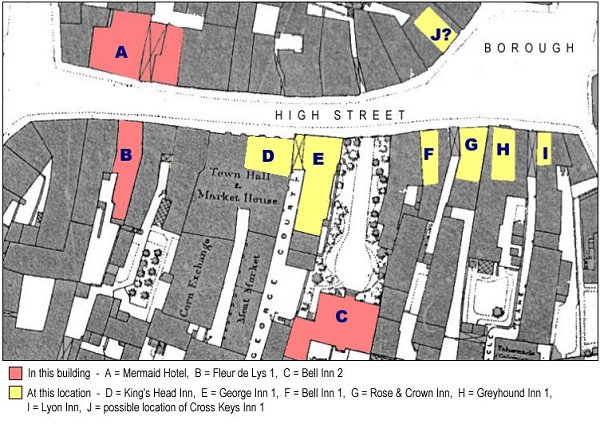
gallery
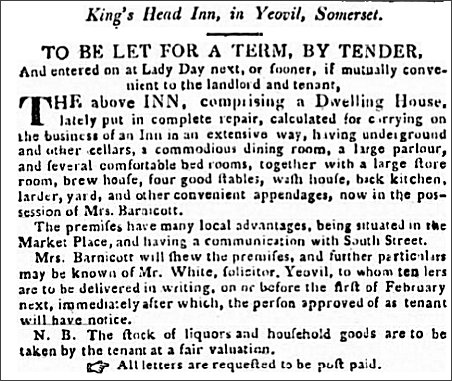
The advertisement for the letting of the King's Head in the 1 January 1823 edition of the Taunton Courier & Western Advertiser.
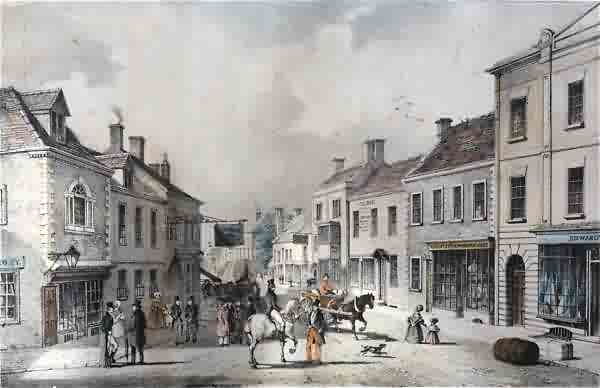
From my
collection
This lithograph looks down High Street from its junction with Hendford / Princes Street. On the left the Mermaid with its familiar archway and large overhanging sign is clearly seen. On the opposite side of the road, just right of centre, the white three storey building with the two-storey projecting bay is the Kings Head Inn. It is likely that the two storey building next to the Kings Head Inn is the building that held the former George Inn.
This hand-tinted stone lithograph was by Henry Burn (1807-1884) entitled 'Market Place - Yeovil'. There are not many known stone lithographs by Henry Burn because he left for Australia in 1852. It was published by William Porter and Henry Marsh Custard in January 1839 and printed by Charles Joseph Hullmandel (1789-1850) of London, where he maintained a lithographic establishment on Great Marlborough Street from about 1819 until his death.
For a more detailed account of the buildings in this 1839 lithograph, click here.
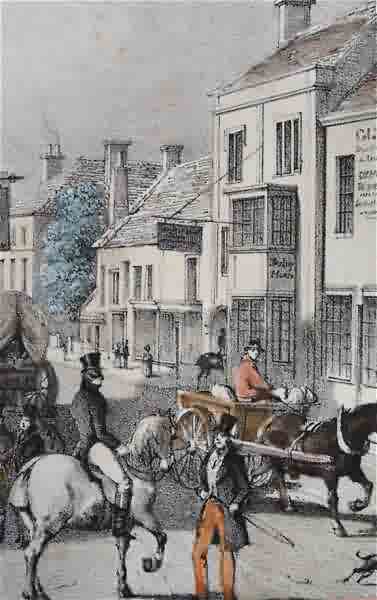
From my
collection
Enlarged from the lithograph above, this is the only image of the King's Head I know of. Look carefully and you will notice a horse being ridden into the arch of the King's Head Inn to the left of the projecting bay windows. This was not the entrance to George Court, which was to its immediate left, but gave access to the King's Head's stabling at the rear.
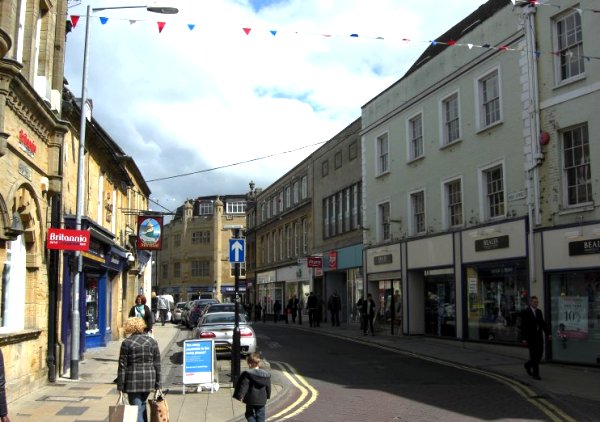
The scene of the previous image, but seen in 2012. This photograph was taken on 02 May 2012 - the day the Queen visited Yeovil as part of her Jubilee Tour. Notice the string of patriotic bunting slung across the road - don't us Yeovilians just know how to celebrate in style!
owners / tenants / licensees
1679 – Henry
Moore (Poor Rate
Extracts) 6d. at
ye King's Head,
Burrow
1689 – Mr Penny
(Poor Rate
Extracts) 6d.
for ye King's
Head, Burrough
1822 – Thomas
Barnicott
(Pigot’s 1822
Directory)
1823 – Mrs Barnicott
(advert above)
1824 – Thomas
Barnicott
(Pigot's 1824
Directory - Inns
& Hotels)
1829 – Mrs
Hayward
Barnicott, owner
- John Symonds,
occupier (Land
Tax Returns)
listed as
Kings Head
Inn
1830 – John
Symonds (Pigot’s
1830 Directory)
1839 – John
Melmoth
(Robson’s 1839
Directory)
1841 – John
Melmoth –
Innkeeper (1841
census) pub not
named but listed
in High Street
1848 – Joseph
Dean - left
King's Head due
to demolition,
moved to
Castle
(Western
Gazette)
1849 –
Demolished
Documentation
|
1737 |
This is to give notice that the Crewkern Carrier Sets out from the George Inn in Crewkern every Saturday at Four o'Clock in the Afternoon, and from his own House in North Perriot near Crewkern very Tuefday Morning by Seven o'Clock: From the King's Head in Yeovil at Ten:.... and will be at the White Horse Inn in Friday Street, London, every Saturday morning. N.B. He will not be accountable for any Money, Plate, Jewels, Watches, Rings, or Writings pack'd in Boxes, Parcels etc. if lost: Glass or China, if broke, unless enter'd as such, that proper Care may be taken of them, and the same paid for accordingly. Perform'd (if God permit) by Anthony Slade of North Perriot. (The Sherborne Mercury or Weekly Advertiser, October 1737). |
|
1749 |
Lease
- 12 May
1749 -
Henry
Peddle
of
Yeovil,
tallow
chandler,
portreeve
and the
Burgesses
of
Yeovil
AND
Charles
Bewsey*
of
Yeovil,
gent.
Tenement
in High
Street,
formerly
known as
the Cock
in the
Hoop,
and
since as
the
King's
Head.
Rent
16s. |